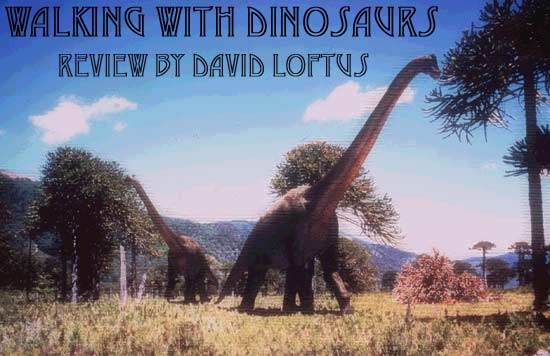|
Part 5: Spirits
of the Ice Forest ("of the Silent Forest" in the book)
Time: 106 million years BCE
Place: "Antarctica,"
part of a giant continent made up of present-day Antarctica, South
America, and Australia
Actual Locations: New Zealand
The setting and cast of this episode
are the most unfamiliar for the veteran dinosaur watcher. Most
of the action takes place in a silent forest a few hundred miles
from the South Pole, a locale that simply didn�t exist in past
popular saurian narratives. It�s a cold, harsh world that is dark
for months on end; everything shows up in a washed-out grey-green.
But it�s not a wasteland or an ice sheet: it�s a dense forest
of ferns, conifers, swampy pools � and the huge flat head of what
looks like a bullfrog pops out to snatch at the corpse of a small
dinosaur on the shore!
The star of this show is Leaellynasaura
(sounds like "Lianna-saura"; was it discovered and named
by a Welshman?), an elegant 7-foot biped with�wait for it�huge
eyes "and an enlarged optic lobe that enabled it to see in
the dark." There�s plenty of animatronic action with these
creatures, who warn one another of predators and scatter; build
nests of rotting leaves to incubate eggs whose temperature they
monitor with sensitive beaks; and chase off an egg-snatching mammal
called Steropodon, a secondary cuddly hero who looks like a cross
between an opossum and a raccoon.
Koolasuchus is the heavy: 16 feet
long but only 1 foot high, it looks like a giant, squashed salamander
with an outsized arrow-shaped head. It�s actually a throwback
to a time before the dinosaurs: an amphibian that survived only
in the polar regions because it was too cold for crocodiles. Koolashuchus
hibernates in the swamp during the winter, and makes a laborious
200-meter crawl to its summer quarters in the river. A Dwarf Allosaur,
"only" 20 feet long, provides some additional threat
to our cuddly heroes as well.
The big dumb-guy role is taken
by Muttaburrasaurus, an herbivore whose enlarged snout (the head
looks like a camel�s with yellow balloons on its nose) may have
been useful for making distinctive calls. We get a closeup of
blood-sucking insects on its ears and eyes. A lizard known as
the Tuatara, another reptile that predates the dinosaurs but will
live on into present-day New Zealand, makes an appearance, as
does the Weta, a giant brown cricket-like insect.
As the lighter part of the year
winds down, plant photosynthesis stops, Southern Lights dance
across the sky, there�s a time lapse sequence of ice crystals
and creamy ice forming on various objects, and the scene turns
almost pitch black under the trees. "But with image-enhancement,
it is possible to get a Leaellynasaura�s-eye view of the clan,"
says Branagh, and the visuals of frozen ground and pools, of the
clan gone into suspended animation, resemble infrared photography.
|

